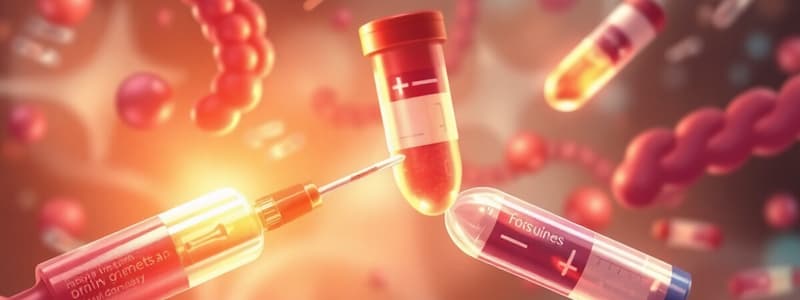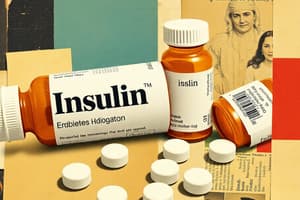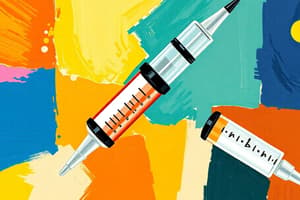Podcast
Questions and Answers
A patient receives a dose of insulin lispro at 7:00 AM. At what time would the nurse anticipate the highest risk for hypoglycemia?
A patient receives a dose of insulin lispro at 7:00 AM. At what time would the nurse anticipate the highest risk for hypoglycemia?
- 8:00 AM - 9:00 AM (correct)
- 11:00 AM - 12:00 PM
- 7:15 AM - 8:00 AM
- 3:00 PM - 4:00 PM
Which statement accurately contrasts the action profiles of rapid-acting and short-acting insulins?
Which statement accurately contrasts the action profiles of rapid-acting and short-acting insulins?
- Rapid-acting insulins are preferred for basal insulin coverage, whereas short-acting insulins are used for bolus coverage.
- Rapid-acting insulins more closely mimic the body's natural insulin response to meals compared to short-acting insulins. (correct)
- Short-acting insulins have a quicker onset and shorter duration compared to rapid-acting insulins.
- Rapid-acting insulins are typically administered intravenously, while short-acting insulins are given subcutaneously.
Before administering NPH insulin, the nurse notices the insulin appears cloudy. What is the most appropriate action by the nurse?
Before administering NPH insulin, the nurse notices the insulin appears cloudy. What is the most appropriate action by the nurse?
- Check the expiration date and, if current, gently roll the vial between the hands to mix the suspension. (correct)
- Discard the vial, as cloudy appearance indicates contamination.
- Administer the insulin without further action; this is an expected appearance.
- Shake the vial vigorously to ensure the medication is properly mixed.
A patient prescribed insulin glargine asks why they must take it at the same time each day. What is the nurse's best response?
A patient prescribed insulin glargine asks why they must take it at the same time each day. What is the nurse's best response?
What is the primary pathological difference between Type 1 and Type 2 diabetes mellitus?
What is the primary pathological difference between Type 1 and Type 2 diabetes mellitus?
Which statement provides the most accurate guidance regarding exercise for a patient with diabetes?
Which statement provides the most accurate guidance regarding exercise for a patient with diabetes?
Which of the following represents the MOST critical step in educating a patient about sick day management?
Which of the following represents the MOST critical step in educating a patient about sick day management?
A patient with type 2 diabetes who takes oral medications reports frequent episodes of hypoglycemia. What is the MOST important initial action the nurse should take?
A patient with type 2 diabetes who takes oral medications reports frequent episodes of hypoglycemia. What is the MOST important initial action the nurse should take?
Inpatient is admitted with DKA. Which of the following orders should the nurse question?
Inpatient is admitted with DKA. Which of the following orders should the nurse question?
The nurse is teaching a client who takes insulin. Which statement indicates a need for further teaching?
The nurse is teaching a client who takes insulin. Which statement indicates a need for further teaching?
What distinguishes MODY (Maturity-Onset Diabetes of the Young) from Type 1 and Type 2 diabetes?
What distinguishes MODY (Maturity-Onset Diabetes of the Young) from Type 1 and Type 2 diabetes?
A patient newly diagnosed with diabetes is overwhelmed by the amount of information provided during education sessions. Which nursing intervention is MOST effective in promoting the patient's adherence to a new diabetes management plan?
A patient newly diagnosed with diabetes is overwhelmed by the amount of information provided during education sessions. Which nursing intervention is MOST effective in promoting the patient's adherence to a new diabetes management plan?
How does gestational diabetes (GDM) typically differ from pre-existing Type 1 or Type 2 diabetes in terms of management and long-term implications?
How does gestational diabetes (GDM) typically differ from pre-existing Type 1 or Type 2 diabetes in terms of management and long-term implications?
A patient taking insulin reports noctural hypoglycemia. Which intervention should the nurse suggest?
A patient taking insulin reports noctural hypoglycemia. Which intervention should the nurse suggest?
A client newly diagnosed with type 1 DM asks why they can't take an oral medication instead of insulin. What should the nurse tell them?
A client newly diagnosed with type 1 DM asks why they can't take an oral medication instead of insulin. What should the nurse tell them?
A patient with diabetes develops a foot ulcer. What should the nurse include in patient teaching?
A patient with diabetes develops a foot ulcer. What should the nurse include in patient teaching?
A nurse is planning diabetes education with a client. What is the priority goal?
A nurse is planning diabetes education with a client. What is the priority goal?
A nurse is assessing a client with poorly controlled DM. Which finding would indicate the presence of long-term complications from DM?
A nurse is assessing a client with poorly controlled DM. Which finding would indicate the presence of long-term complications from DM?
Which of the following is the MOST significant risk factor for developing Type 2 Diabetes?
Which of the following is the MOST significant risk factor for developing Type 2 Diabetes?
What specific instruction regarding foot care is MOST crucial for a nurse to provide to a patient with diabetes to prevent complications?
What specific instruction regarding foot care is MOST crucial for a nurse to provide to a patient with diabetes to prevent complications?
Flashcards
Rapid-Acting Insulin
Rapid-Acting Insulin
Insulin lispro, aspart, and glulisine. Onset in 10-15 mins, peaks in 1-2 hrs, lasts 3-5 hrs.
Short-Acting Insulin
Short-Acting Insulin
Regular insulin (Humulin R, Novolin R). Onset 30-60 mins, peak 2-4 hrs, duration 5-8 hrs. Can be administered IV or Subcutaneously.
Intermediate-Acting Insulin
Intermediate-Acting Insulin
NPH insulin (Humulin N, Novolin N). Onset 1-2 hrs, peak 4-12 hrs, duration 12-18 hrs. Cloudy; roll to mix.
Long-Acting Insulin
Long-Acting Insulin
Signup and view all the flashcards
Type 1 Diabetes
Type 1 Diabetes
Signup and view all the flashcards
Type 2 Diabetes
Type 2 Diabetes
Signup and view all the flashcards
Gestational Diabetes Mellitus (GDM)
Gestational Diabetes Mellitus (GDM)
Signup and view all the flashcards
Nursing care: Assessment
Nursing care: Assessment
Signup and view all the flashcards
Nursing care: Medications
Nursing care: Medications
Signup and view all the flashcards
Nursing care: Nutrition
Nursing care: Nutrition
Signup and view all the flashcards
Nursing care: Exercise
Nursing care: Exercise
Signup and view all the flashcards
Nursing care: Hypoglycemia
Nursing care: Hypoglycemia
Signup and view all the flashcards
Nursing care: DKA/HHS
Nursing care: DKA/HHS
Signup and view all the flashcards
Nursing care: Education
Nursing care: Education
Signup and view all the flashcards
Patient Teaching
Patient Teaching
Signup and view all the flashcards
Complications of diabetes
Complications of diabetes
Signup and view all the flashcards
Study Notes
Types of Insulin
- Rapid-acting insulin examples include insulin lispro (Humalog), insulin aspart (NovoLog), and insulin glulisine (Apidra).
- Rapid-acting insulin has an onset of 10-15 minutes, peaks in 1-2 hours, and lasts for 3-5 hours; it should be taken before meals and requires monitoring for hypoglycemia.
- Short-acting insulin like regular insulin (Humulin R, Novolin R) starts working in 30-60 minutes, peaks in 2-4 hours, and lasts 5-8 hours; it can be administered intravenously or subcutaneously 30 minutes before meals.
- Intermediate-acting insulin, such as NPH insulin (Humulin N, Novolin N), has an onset of 1-2 hours, peaks in 4-12 hours, and lasts 12-18 hours; this cloudy insulin should be rolled to mix and is often taken twice daily (BID).
- Long-acting insulin like insulin glargine (Lantus) and insulin detemir (Levemir) starts working in 1-2 hours, has a minimal peak, and lasts approximately 24 hours; it should not be mixed and should be taken at the same time daily.
Types of Diabetes
- Type 1 Diabetes (T1DM) is caused by autoimmune beta-cell destruction and requires lifelong insulin, carbohydrate counting, and blood glucose monitoring.
- Type 2 Diabetes (T2DM) results from insulin resistance and beta-cell dysfunction, with risk factors including obesity, sedentary lifestyle, and family history; treatment involves lifestyle changes, oral medications, and insulin as needed.
- Gestational Diabetes (GDM) is due to hormonal insulin resistance during pregnancy and is managed with diet, exercise, and insulin if needed.
- Other specific types of diabetes include MODY, LADA, and forms caused by secondary factors like steroids or pancreatitis.
Nursing Care for Diabetes
- Assessment includes monitoring blood glucose, assessing symptoms, and reviewing adherence to treatment plans.
- Nursing interventions involve educating patients on proper medication use and side effects, nutrition (carb counting, balanced diet), encouraging exercise, and monitoring blood glucose.
- Hypoglycemia should be treated with 15g of carbohydrates, with a recheck in 15 minutes.
- Monitor hydration and administer insulin/fluids for DKA/HHS.
- Education is crucial for monitoring, understanding sick day rules, and practicing foot care.
Patient Teaching
- Daily foot inspections, understanding sick day insulin use, and recognizing warning signs are important.
- Potential complications include eye, kidney, nerve, and cardiovascular diseases.
Studying That Suits You
Use AI to generate personalized quizzes and flashcards to suit your learning preferences.




